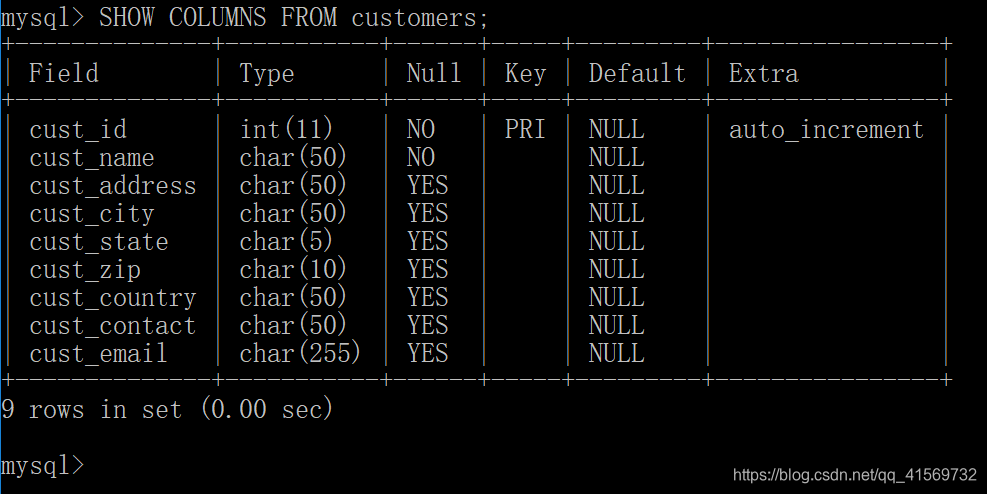第3章 使用MySQL
简单记录 - MySQL必知必会 - [英]Ben Forta
将学习如何连接和登录到MySQL,如何执行MySQL语句,以及如何获得数据库和表的信息。
连接
连接到MySQL,需要以下信息:
-
主机名(计算机名)——如果连接到本地MySQL服务器,为localhost;
-
一个合法的用户名;如root;
-
端口(如果使用默认端口3306之外的端口);
-
用户口令(你的用户名对应设置的密码)。
在连接之后,就可以访问登录名能够访问的任意数据库和表了
登录:mysql 【-h 主机名 -P 端口号】 -u 用户名 -p密码
退出:exit或ctrl+C
mysql 【-h 主机名 -P 端口号】 -u 用户名 -p密码
例子:mysql -h localhost -P3306 -u root -p123456 前面三个有没有空格都行,-p必须没有空格
-P是port端口号的意思,-h是host主机的意思,localhost是本地主机的意思。
如果是本地登录和使用默认端口3306的话,可以这样登录
mysql -u root -p123456
C:Usersx1c>mysql -h localhost -P 3306 -u root -p123456
mysql: [Warning] Using a password on the command line interface can be insecure.
Welcome to the MySQL monitor. Commands end with ; or g.
Your MySQL connection id is 6
Server version: 5.7.28 MySQL Community Server (GPL)
Copyright (c) 2000, 2019, Oracle and/or its affiliates. All rights reserved.
Oracle is a registered trademark of Oracle Corporation and/or its
affiliates. Other names may be trademarks of their respective
owners.
Type 'help;' or 'h' for help. Type 'c' to clear the current input statement.
mysql> exit
Bye
C:Usersx1c>mysql -h localhost -P 3306 -u root -p
Enter password: ******
Welcome to the MySQL monitor. Commands end with ; or g.
Your MySQL connection id is 7
Server version: 5.7.28 MySQL Community Server (GPL)
Copyright (c) 2000, 2019, Oracle and/or its affiliates. All rights reserved.
Oracle is a registered trademark of Oracle Corporation and/or its
affiliates. Other names may be trademarks of their respective
owners.
Type 'help;' or 'h' for help. Type 'c' to clear the current input statement.
mysql> exit
Bye
C:Usersx1c>mysql -u root -p
Enter password: ******
Welcome to the MySQL monitor. Commands end with ; or g.
Your MySQL connection id is 8
Server version: 5.7.28 MySQL Community Server (GPL)
Copyright (c) 2000, 2019, Oracle and/or its affiliates. All rights reserved.
Oracle is a registered trademark of Oracle Corporation and/or its
affiliates. Other names may be trademarks of their respective
owners.
Type 'help;' or 'h' for help. Type 'c' to clear the current input statement.
mysql>

选择数据库
连接到MySQL后,选择一个数据库操作,选择数据库可使用USE关键字。
术语:关键字(key word) 作为MySQL语言组成部分的一个保留字,我们不能用关键字命名一个表或列。
例如,为了使用mysqlcrashcourse数据库,应该输入以下内容USE mysqlcrashcourse:
mysql> USE mysqlcrashcourse;
Database changed
mysql>
分析:USE mysqlcrashcourse选择mysqlcrashcourse数据库,Database changed消息代表是mysql命令行程序选择数据库mysqlcrashcourse成功
注意:我们必须先使用USE打开对应的数据库,才能读取数据库中的数据。
了解数据库和表
如果不知道可以使用的数据库名时怎么办?
怎样能显示可用的数据库列表呢?
数据库、表、列、用户、权限等的信息被存储在数据库和表中(MySQL使用MySQL来存储这些信息)。不过,内部的表一般不直接访问。可用MySQL的SHOW命令来显示这些信息(MySQL从内部表中提取这些信息)。请看下面的例子:
mysql> SHOW DATABASES;
+--------------------+
| Database |
+--------------------+
| information_schema |
| mmall_learning |
| mysql |
| mysqlcrashcourse |
| performance_schema |
| spring |
| sys |
+--------------------+
7 rows in set (0.00 sec)
SHOW DATABASES;返回可用数据库的一个列表。包含在这个列表中的可能是MySQL内部使用的数据库(如例子中的mysql和information_schema等)。当然,还有很多自己创建的数据库(如mmall_learning,mysqlcrashcourse,,spring都是我之前创建的。)。
为了获得一个数据库内的表的列表,使用SHOW TABLES命令;如下所示:
mysql> SHOW TABLES;
+----------------------------+
| Tables_in_mysqlcrashcourse |
+----------------------------+
| customers |
| orderitems |
| orders |
| productnotes |
| products |
| vendors |
+----------------------------+
6 rows in set (0.01 sec)
mysql>
SHOW TABLES;返回当前选择的数据库内可用表的列表。SHOW也可以用来显示某个表的列,如显示customers表的所有列:
mysql> SHOW COLUMNS FROM customers;
+--------------+-----------+------+-----+---------+----------------+
| Field | Type | Null | Key | Default | Extra |
+--------------+-----------+------+-----+---------+----------------+
| cust_id | int(11) | NO | PRI | NULL | auto_increment |
| cust_name | char(50) | NO | | NULL | |
| cust_address | char(50) | YES | | NULL | |
| cust_city | char(50) | YES | | NULL | |
| cust_state | char(5) | YES | | NULL | |
| cust_zip | char(10) | YES | | NULL | |
| cust_country | char(50) | YES | | NULL | |
| cust_contact | char(50) | YES | | NULL | |
| cust_email | char(255) | YES | | NULL | |
+--------------+-----------+------+-----+---------+----------------+
9 rows in set (0.00 sec)
mysql>

分析:
SHOW COLUMNS要求给出一个表名(这个例子中的FROM customers),它对每个字段返回一行,行中包含字段名、数据类型、是否允许NULL、键信息、默认值以及其他信息(如字段cust_id的auto_increment)。
说明:什么是自动增量? 某些表列需要唯一值。例如,(上面例子中所示的)顾客ID。在每个行添加到表中时,MySQL可以自动地为每个行分配下一个可用编号,不用在添加一行时手动分配唯一值(这样做必须记住最后一次使用的值)。这个功能就是所谓的自动增量。如果需要它,则必须在创建表时把它作为表定义的组成部分。
提示:DESCRIBE语句 MySQL支持用DESCRIBE作为SHOW COLUMNS FROM的一种快捷方式。换句话说,DESCRIBE customers;是SHOW COLUMNSFROM customers;的一种快捷方式。

所支持的其他SHOW语句还有:
-
SHOW STATUS,用于显示广泛的服务器状态信息;
-
SHOW CREATE DATABASE和SHOW CREATE TABLE,分别用来显示创建特定数据库或表的MySQL语句;
-
SHOW GRANTS,用来显示授予用户(所有用户或特定用户)的安全权限;
mysql> show grants; +---------------------------------------------------------------------+ | Grants for root@localhost | +---------------------------------------------------------------------+ | GRANT ALL PRIVILEGES ON *.* TO 'root'@'localhost' WITH GRANT OPTION | | GRANT PROXY ON ''@'' TO 'root'@'localhost' WITH GRANT OPTION | +---------------------------------------------------------------------+ 2 rows in set (0.00 sec) -
SHOW ERRORS和SHOW WARNINGS,用来显示服务器错误或警告消息。
提示:
进一步了解SHOW请在mysql命令行实用程序中,执行命令HELP SHOW;显示允许的SHOW语句。
mysql> HELP SHOW;
Name: 'SHOW'
Description:
SHOW has many forms that provide information about databases, tables,
columns, or status information about the server. This section describes
those following:
SHOW {BINARY | MASTER} LOGS
SHOW BINLOG EVENTS [IN 'log_name'] [FROM pos] [LIMIT [offset,] row_count]
SHOW CHARACTER SET [like_or_where]
SHOW COLLATION [like_or_where]
SHOW [FULL] COLUMNS FROM tbl_name [FROM db_name] [like_or_where]
SHOW CREATE DATABASE db_name
SHOW CREATE EVENT event_name
SHOW CREATE FUNCTION func_name
SHOW CREATE PROCEDURE proc_name
SHOW CREATE TABLE tbl_name
SHOW CREATE TRIGGER trigger_name
SHOW CREATE VIEW view_name
SHOW DATABASES [like_or_where]
SHOW ENGINE engine_name {STATUS | MUTEX}
SHOW [STORAGE] ENGINES
SHOW ERRORS [LIMIT [offset,] row_count]
SHOW EVENTS
SHOW FUNCTION CODE func_name
SHOW FUNCTION STATUS [like_or_where]
SHOW GRANTS FOR user
SHOW INDEX FROM tbl_name [FROM db_name]
SHOW MASTER STATUS
SHOW OPEN TABLES [FROM db_name] [like_or_where]
SHOW PLUGINS
SHOW PROCEDURE CODE proc_name
SHOW PROCEDURE STATUS [like_or_where]
SHOW PRIVILEGES
SHOW [FULL] PROCESSLIST
SHOW PROFILE [types] [FOR QUERY n] [OFFSET n] [LIMIT n]
SHOW PROFILES
SHOW RELAYLOG EVENTS [IN 'log_name'] [FROM pos] [LIMIT [offset,] row_count]
SHOW SLAVE HOSTS
SHOW SLAVE STATUS [FOR CHANNEL channel]
SHOW [GLOBAL | SESSION] STATUS [like_or_where]
SHOW TABLE STATUS [FROM db_name] [like_or_where]
SHOW [FULL] TABLES [FROM db_name] [like_or_where]
SHOW TRIGGERS [FROM db_name] [like_or_where]
SHOW [GLOBAL | SESSION] VARIABLES [like_or_where]
SHOW WARNINGS [LIMIT [offset,] row_count]
like_or_where:
LIKE 'pattern'
| WHERE expr
If the syntax for a given SHOW statement includes a LIKE 'pattern'
part, 'pattern' is a string that can contain the SQL % and _ wildcard
characters. The pattern is useful for restricting statement output to
matching values.
Several SHOW statements also accept a WHERE clause that provides more
flexibility in specifying which rows to display. See
https://dev.mysql.com/doc/refman/5.7/en/extended-show.html.
URL: https://dev.mysql.com/doc/refman/5.7/en/show.html
mysql>
小结
简单介绍了如何连接和登录MySQL,如何用USE选择数据库,如何用SHOW查看MySQL数据库、表和内部信息。
mysql -h localhost -P 3306 -u root -p123456;
use mysqlcrashcourse;
show databases;
show tables;
show columns from customers;
help show;
show status;
show grants;
show grants;
show errors;
show warnings;